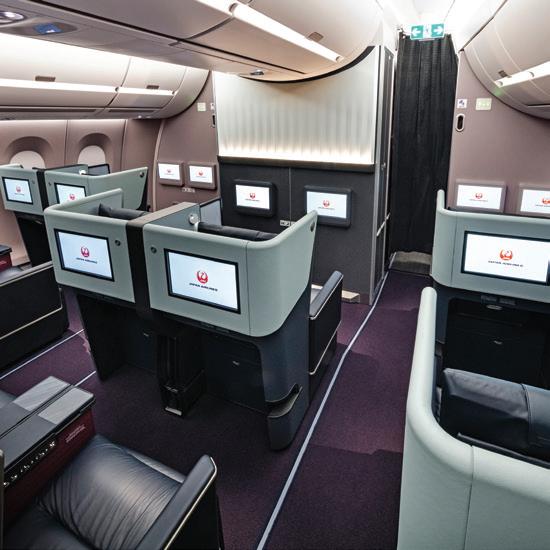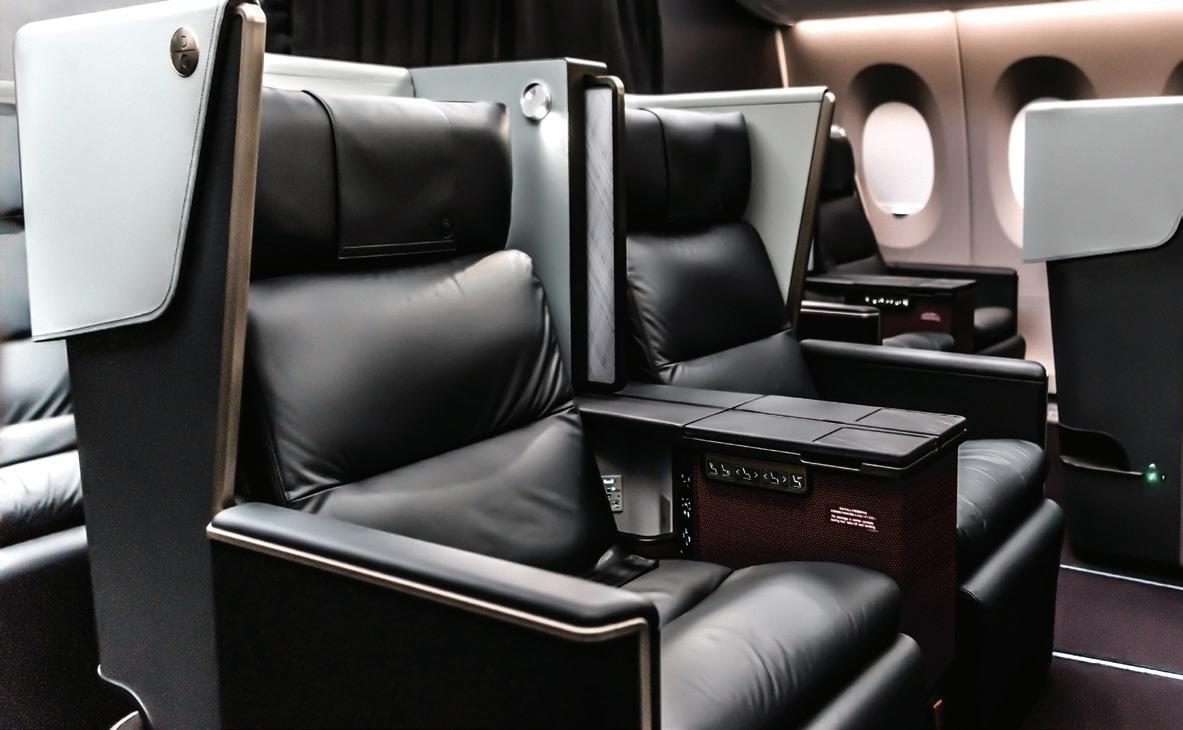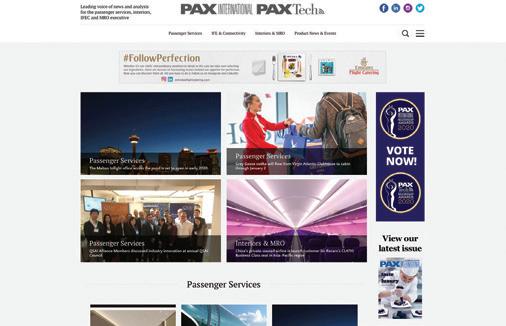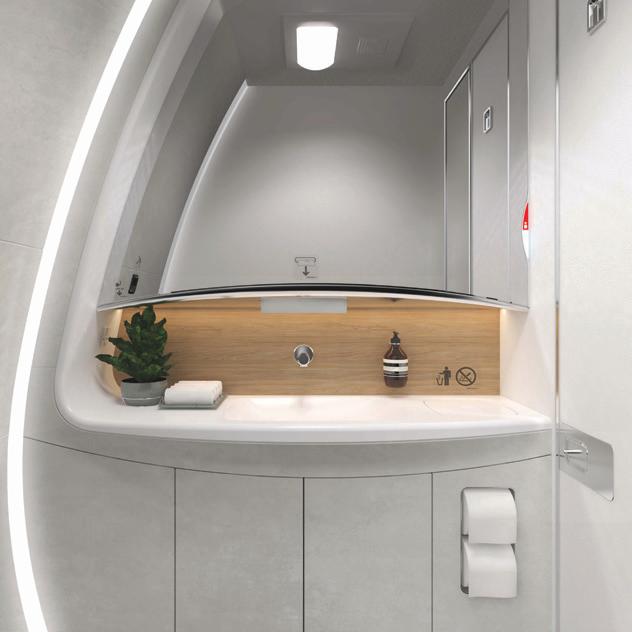
10 minute read
RETROFIT’S MODERN MAKEOVER Leading interior design companies discuss their approaches to retrofit designs, share their insights on sustainability and highlight successful projects
RETROFIT’S MODERN MAKEOVER MRO
tangerine’s new Infused Essence design strategy for JAL’s domestic and international fleet aims to capture the essence of Japanese identity
The design collaboration between JAL and tangerine won Gold for Best Passenger Experience Initiative at the APEX-FTE Asia Awards 2019

Projections for new aircraft manufacturing and delivery over the next several years may be staggering, but design companies and airlines still rely heavily on established fleet, bringing high demand to the industry’s retrofit sector. PAX Tech set out to uncover the reasons companies turn to retrofitting. For many, passenger expectations are at the forefront. Easing passenger travel anxiety with more spacious overhead storage and creating a sense of familiar comfort in lavatories, all with an eye on sustainability, are just a few considerations that are driving design decisions. Leading interior design companies discuss their approaches to retrofit designs, share their insights on sustainability and highlight successful projects by MARY JANE PITTILLA
Design house tangerine designed a new full-service bar with face-to-face service for Virgin Australia’s retrofitted 777, while retaining the high seat numbers

Safran Cabin “The key to a retrofit interior is understanding what already works well for a customer and what needs to change; and focusing on making the upgrade seamless while reusing the parts that are still working well and in good condition,” explains Nathan Kwok, Vice President Marketing at Safran Cabin. The cabin interiors specialist designs its retrofit process to minimize the time the aircraft is on the ground, ideally performing the entire upgrade overnight, so the aircraft can be back up in the air by daylight. “Time is money,” he says. The company is seeing a lot of demand for larger overhead bins in retrofit programs. “Airlines want to put an end to ‘bag anxiety’. Passengers should never have to worry about finding a space for their bag, even if they are the last one on the plane. This also helps the airlines get up in the air faster, because passengers are able to stow their bag right at their seat and grab it quickly when it’s time to go.” Safran Cabin recently introduced to the market its ECOS bin retrofit program, available on A320 and Embraer E-Jet aircraft for immediate retrofit. This bin system means every passenger has a space for their bag; and has been shown to improve turnaround time for airlines.
Sustainability gets more important every day – and it has many dimensions, according to Kwok. The first dimension
is related to the approach previously described, which is designing flexible solutions so that airlines don’t have to buy more than they need. This saves money but it also means they are not overconsuming. The second-dimension centers on how the company can make interiors recyclable. Its ECOForm line of ceilings and sidewalls are designed to be easily refurbished, so they can have a longer service life, and when they finally reach their end of life, they can be recycled into other products. Finally, emerging connectivity technologies such as Safran’s connected meal trolley, Sophy, uses sensors and wireless connectivity to streamline airline operations, reducing food waste and transportation costs. Safran Cabin is seeing a retrofit sector that will remain healthy and active for years to come, as most airline fleets around the world are growing, and getting new aircraft in the process. “Our retrofit interior products bring their older aircraft up to the most modern standards and even exceed what they can get from a new aircraft,” Kwok concludes.
tangerine Design consultancy firm tangerine takes a client-focused approach to retrofit programs. “From a design team’s perspective, the key difference between a retrofit and line fit program is that during a retrofit you don’t have a program structure with the airframe manufacturer,”
PriestmanGoode’s design for the First Class La Première suites onboard Air France aims to embody French elegance, with leather, suede and touches of wood and metal creating a sophisticated cabin

says Matt Round, Chief Creative Officer at tangerine. “However, this doesn’t necessarily have a negative impact on the design as the constraints are more around the client’s ambitions and their timescales for the project.” In 2019, tangerine’s design collaboration with Japan Airlines (JAL) launched to market, which included creating a new design strategy called Infused Essence for its domestic and international fleet. The strategy captured the essence of Japanese identity and embodied it in a contemporary travel experience for both native and international visitors to Japan. It was first created for JAL’s A350-900 line fit program for the domestic market and then was applied to its retrofit 777 international aircraft to create a coherent customer experience across the fleet. The collaboration won Gold for Best Passenger Experience Initiative at the APEX-FTE Asia Awards 2019. In 2014, tangerine worked with Virgin Australia to create a new cabin interior, helping to transform the positioning of the brand from being a low-cost carrier into a premium full-service carrier. In the retrofitted 777 aircraft, Virgin Australia previously didn’t have space for a staffed bar. Through an innovative approach to the design of the LOPA (Layout of Passenger Accommodations) and onboard products, tangerine designed a new full-service bar offering with face-to-face service, while retaining the high seat numbers. “This has become a signature of the international aircraft,” notes Round. A distinctive Business Class cabin interior offering was created based on the Collins Aerospace Super Diamond Business Class seat, and in Premium Economy the new design language for the cabin interior was implemented to refurbish the existing seating.
On the subject of sustainability in retrofit, Round said he believes that after a long time, there is finally a heightened awareness of sustainability in aviation. This is affecting
28 | PAX TECH | FEBRUARY 2020 PriestmanGoode helped design the exclusive interiors for Air France’s First Class La Première suites onboard the airline’s Boeing 777-300 aircraft

programs as people are looking for materials with a lower environmental impact and solutions that are lighter and reduce fuel burn. “We have observed a trend amongst the aviation supply chain of everyone doing what they can, where they can, to improve sustainability, but there’s still a long way to go,” he says.
PriestmanGoode PriestmanGoode’s retrofit approach can be a lesson in how to harmoniously overlay a new design within a legacy cabin design or an opportunity to really push the boundaries, according to Chris Parker, the company’s Director.
He notes that retrofit aircraft often retain some of the pre-existing products, finishes and materials. The results can end up being a hybrid between the old and new design depending on the ability to replace existing products. The new design often requires careful adjustment to harmonize with the retained elements of the existing design. With retrofit programs, although the certification is the same, there are more design opportunities because you are not constrained by the airframers’ catalog and program time constraints, he observes.
Stay in touch with &

IN PRINT PAX issues are distributed at some of the biggest international onboard services, aircraft interiors and MRO trade shows around the world.


IN YOUR INBOX Get breaking industry news weekly to your inbox, and copies of our digital issues as soon as they are available.


ONLINE Our website is updated daily with content from the seating, interiors, IFEC and MRO industries, plus onboard catering and passenger services news.
For advertising queries, please contact kevin@pax-intl.com
A successful retrofit project was the launch of the exclusive interiors for Air France’s First Class La Première suites onboard the airline’s 777-300 aircraft, in which PriestmanGoode worked in close collaboration with Air France, B/E Aerospace (now Collins Aerospace) and Brand Image. The cabin interiors seek to embody French elegance, with leather, suede and touches of wood and metal creating a sophisticated cabin. Some of the key retrofit trends in the market are customized social spaces and upgraded cabin lighting, notes Parker. Retrofitting allows outdated products, especially Business Class seats, to be upgraded to the latest industry standards.
Sustainability is important in retrofit, he believes. “Retrofit is all about sustainability; so while older aircraft may not be as efficient as the very latest aircraft flying, keeping an aircraft in the sky for as long as possible is a much more sustainable approach than scrapping it when you consider the energy required to produce a new aircraft. As with new line fit aircraft, everything that goes onboard a retrofit aircraft needs to be considered with sustainability in mind. That means less weight equals less fuel burn, use of materials that can be recycled and materials selected for longer lifespan.”
Acumen Design Associates Mike Crump, Brand Experience Director at Acumen Design Associates, says there is no real difference in the company’s approach between retrofit and new aircraft programs. “Whether it is a simple refresh of CMF [color, materials, finish], introducing or adapting a new product for different aircraft types, or implementing a new brand identity across legacy aircraft – our principles remain the same: finding ways to innovate in the cabin and improve the passenger experience.” However, he notes that there is one key difference, as timescales for new product development are usually much shorter in retrofit programs than line fit as they are not restricted by the key milestones and development lead times set by the two main aircraft manufacturers. There is also potential to do greater levels of customization to the cabin design monuments during retrofit programs. For new aircraft there are more SFE interior monuments that have to be chosen from a restricted catalogue, meaning the scope of change can be higher in retrofits if the airline is prepared to invest in creative designs for its cabins, galleys, lavatories and bars.
Safran Cabin’s ECOS bin system means every passenger has a space for their bag, and has been shown to improve turnaround time Acumen Design Associates recently worked with ST Engineering to develop ARC, a new modular lavatory design for legacy aircraft such as the 777


While much of Acumen’s work in recent years has been line fit, Acumen recently worked with ST Engineering to develop ARC, a new modular lavatory design for legacy aircraft such as the 777. In recent years onboard bathroom standards have been elevated by the contemporary design treatment in newer aircraft types. In contrast, the legacy 777 bathroom is now 25 years old and fails to meet passenger expectations. ARC combines modern design with cutting-edge hygiene technologies to offer a sophisticated design for 777 interiors, creating highly functional Zen spaces that prioritize hygiene and instill a sense of well-being while improving the experience across all classes.
Crump says climate change is reshaping aviation interior design, with airlines and designers becoming increasingly aware of their responsibilities to buy and design products which are sustainably made. However, in Acumen’s experience, it is still unusual for airlines to specify sustainable goals in their RFPs, regardless of whether it is a retrofit or line fit program. “This will obviously change,” he adds.
As product lifecycles become shorter and airlines upgrade their cabins more often, the company expects new products will be designed to be more easily recycled and use a greater number of sustainable materials; that way, when a product is removed and updated in a retrofit program, waste is reduced.
Join the leading global event for travel catering, onboard retail and passenger comfort

Source innovative products and services from over 350 international suppliers. Network with over 4,000 onboard professionals including 800 airline and rail buyers. Be inspired by thought provoking presentations and demonstrations.
Co-Located with:
REGISTER NOW 31 March - 2 April 2020 worldtravelcateringexpo.com
Organised by:










